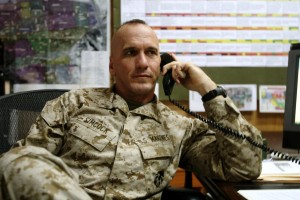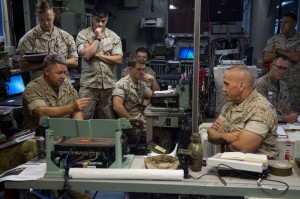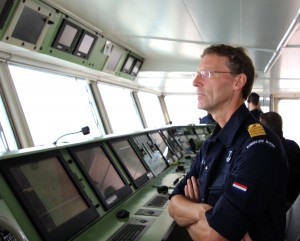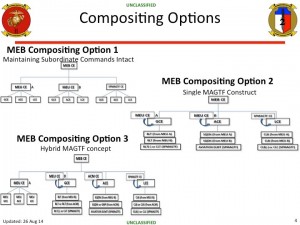2015-04-11 By Robbin Laird
Two documents released over the last year provide a clear direction for the US Navy-Marine Corps team in 21st century operations.
The first is Expeditionary Force 21, which provides a concept for the Marine Corps (MC) to build, equip and train their forces for 21st century operations.
The MC is enabled by the US Navy (USN) amphibious fleet, which is equipped and trained for the ROMO (Range of Military Operations).
To do so, the Marines are focusing on evolving their capabilities beyond the PHIBRON (Amphibious Squadron) or ARG (Amphibious Ready Group)/MEU (Marine Expeditionary Unit) level by bringing forces together from across the theater of operations to composite forces.
The goal is to “provide timely and scalable forces for crisis response, allowing commanders to tailor forces to evolving missions and effectively composite modular MAGTFs (Marine Air Ground Task Forces) by combining forward-deployed forces with rapidly deploying forces.”
The second is the periodic Seabasing report highlighting the modernization and evolution of the amphibious task forces from where C2 (Command and Control) and the projection of power is crafted and executed.
The concepts in these documents are being tested and shaped today by the 2d Marine Expeditionary Brigade.
2d MEB’s innovative approach to experimenting with scalable and modular forces requires a core focus on innovations in C2 throughout all phases of force projection.
The 2d MEB CE mission statement highlights its role:
The MEB CE provides a Marine Air Ground Task Force/Joint Task Force (MAGTF/JTF)-capable headquarters that can rapidly deploy and when directed composite with naval and/or land-based forward-deployed and/or rapidly deployable forces to form a MAGTF or the core element of a JTF headquarters in order to fulfill Geographic Combatant Command (GCC) operational requirements.
2d MEB provides GCCs a scalable, C2 capability designed to shape and execute required missions using naval innovation with new and future force modernization initiatives.
Dynamic C2 is a key enabler of the evolving approach for the other three elements of the MAGTF – Ground, Air and Logistics.
In an interview at Camp Lejeune on March 17, 2015, the Commanding General of 2d MEB, MajGen (Major General) Simcock described the way ahead.
Most recently, MajGen Simcock served in the Pacific as Deputy Commander, MARFORPAC (US Marine Corps Forces, Pacific), where LtGen (Lieutenant General) Robling, the recently retired head of MARFORPAC, referred to him as a “real warrior and leader.”
Now, he is at 2d MEB and providing support to Marine operations in South America, Europe, Africa, and the Mediterranean.

Given his wealth of operational experience, MajGen Simcock is a natural fit for leading 2d MEB in its development of innovative C2 capabilities to service GCCs requirements.
During the interview, MajGen Simcock highlighted the shifting MC focus from land-centric operations associated with Iraq and Afghanistan to sea-based operations being prioritized now.
“We have a generation of officers in the Marine Corps who have a perspective based on operations in Afghanistan or Iraq. They landed in a very mature battle space, operated from an existing FOB (Forward Operating Base), already had an established operating area, and knew how long they would be there before rotating out.”
That is not at all the future as Simcock sees it.
He underscored that Marines need to enhance their creativity, flexibility, and naval capabilities to learn how to C2 forces within the ROMO and to project forces in a wide variety of geographic settings.
Learning to operate off amphibious ships in a situation where the Navy is resource constrained means taking a different operational approach to naval warfare as well.
MajGen Simcock focused on the need for Marines to work differently with allies to be able to shape a broader global amphibious fleet approach.
And by amphibious he meant, the ability of Marines working with allies to operate from a diversity of ships operating as potential members of a coalition sea base.
“I would love to have 50 large deck amphibs (amphibious ships). I do not. We must find other ways to work such as more effectively leveraging the T-AKE (Dry Cargo/Ammunition) ships, which are 42,000-ton ships. One of the bumper stickers I used when out in the Pacific was that if it floats or flies across the Pacific, there should be Marines on it.”
The partner nation and interagency piece is core to MajGen Simcock’s approach.
“Threats in the Pacific, Europe and elsewhere are leading partner nations and allies to shape their own capabilities.
We have international and intragovernmental agencies that want to engage with us and want to train with us.
They want to develop an amphibious capability because of what they’ve seen in their regions.”
He emphasized the impact of events such as the response to disasters in Japan and the Philippines, which highlight the importance of being able to employ for a short period of time, have a significant effect, and leave.
He also highlighted the central importance of having a self-sustaining naval force operating from the sea.
I call that commuting to work. My home comes with me and all those critical war fighting functions: maneuver, communications, logistics and fires.
All those capabilities are the foundation of my home, and I can move that home anywhere I want.
When I say commute to work, I am referring to the ability to operate across the ROMO (Range of Military Operations) from the low end of engagement, up through HADR, and all the way up to regional conflict.”
He also underscored the importance of seabasing for operational flexibility.
The days of us building bases, like we had in the Philippines, are gone, and they’re not coming back.
A beauty of ships is they’re floating sovereignty. You don’t have to ask.
They are there all the time.
He emphasized that allies and partners are augmenting our naval capabilities, including amphibs, and they are working with the USN-MC team to shape their own capabilities.
From the MC standpoint, the key is to develop joint, interagency and international interoperability for operations.
“If it floats or flies, there needs to be Marines on it, same with our coalition partners.
If it floats or flies, it has to be interoperable with us.
We need to be able to put Marines on it.
We need to be able to start conducting operations so that we can work together, that we’re interoperable. Easily said, you’d be surprised how difficult that is.”
2d MEB is clearly focused on working international naval relationships, which played a key role in Bold Alligator 2014 and Exercise African Lion 2014, the largest exercise on the African continent.

In Bold Alligator, the Marines worked an interwoven C2 relationship with the Dutch, who also commanded the USS Arlington, a new US Navy LPD, and worked for and adjacent to the Navy-Marine Corps construct.
Coalition participation required installing CENTRIXS, an allied communication system, on the USS Kearsarge, which improved the forces’ readiness for future crisis and contingency operations.
Throughout the exercise, 2d MEB experimented with various configurations of MAGTF C2 support for operations by leveraging the enhanced US and allied seabase.
In order to facilitate C2 aboard limited amphibious ships, 2d MEB experimented with a robust reachback capability.
Reachback capability allowed 2d MEB to deploy a small part of the staff on ships but employ the whole staff using modern communications technology from a land-based structure given the ships’ space constraints.
https://sldinfo.com/the-way-ahead-after-bold-alligator-2012-a-coalition-perspective/
2d MEB is a standing operational HQ with no forces assigned.
This provides flexibility to GCCs. Because 2d MEB was designed with its most likely mission in mind – crisis response – the unit needs to be able to deploy and provide C2 within 24 hours after heeding a GCC’s request.
The lack of force structure outside the CE allows the unit to serve as the Swiss army knife of C2 for the GCC.
2d MEB can deploy the CE and composite joint and international forces already close to the operating area.
The flexibility of the MEB CE also allows the unit to deploy and employ scalable force packages of as little as a few thousand personnel for crisis response and up to 15,000 for its most deadly mission – small-scale conventional warfare.
This is important for warfighting and operating throughout the ROMO the MC engages in.
CJTF (Combined Joint Task Force) capability is important to the 2d MEB CE because of the capabilities and flexibility provided from integration of partner nations into force response options. On the topic of Exercise African Lion, MajGen Simcock noted 2d MEB will be the CJTF CE.
“This is now the largest exercise on the African continent. It used to be Bright Star in Egypt. Now it is African Lion. We are providing the CJTF element, and we are in the final stages of being validated by AFRICOM as a JTF.”
Theater Security Cooperation exercises such as African Lion are what the Pentagon refers to as phase zero, or pre-crisis involvement, which is an important point of emphasis for MajGen Simcock.
I am a phase zero guy now.
If you do phase zero right two good things happen.
The first good thing about it is you are training with people and are building at least partnerships … if not alliances.
You are realistically demonstrating in reality unity of purpose with partners and allies.
This is crucial when dealing with adversaries in Europe and the Pacific who are pursuing clear divide and conquer strategies.
The second thing – if phase zero doesn’t work – you now have relationships, interoperability, and agreements.
You have everything that you need, so when you go, you don’t go alone.
And, the partnerships and allies you developed effectively work together
We do a lot better by talking with people, not at them, and listening to their priorities to understand where we overlap and where we don’t.
Illustrative of the approach being shaped at 2d MEB is their engagement in Bold Alligator 2014.

From the perspective of 2d MEB, the objectives of BA 2014 were as follows:
“…Integrate with the navy…composite forward and merge rapidly deploying Marine Corps forces into a cohesive, agile force scaled to the mission…”
“…composited MEB will most likely comprise some combination of forward-deployed forces, rapidly deploying forces, and land or maritime prepositioning forces.”
In practice, this meant working a relationship with US forces under Dutch command and at the same time providing a scalable, modular force for the operations exercised.
Executing the largest amphibious exercise on the East Coast required the unit to composite forces already on scene with mission-tailored forces deployed in support. In exercising C2, the MEB focused on different force packages for employing composited forces.
The first option was divergent from the normal MC MAGTF (Marine Air Ground Task Force) concept by maintaining the subordinate MAGTFs intact for operations.
This meant 2d MEB did not command a single MAGTF but instead commanded multiple MAGTFs.
The second one was to use a single MAGTF construct with forces commanded by the MAGTF commander.
The third was hybrid MAGTF concept where core elements of the subordinate MAGTFs were interwoven yet organically operating under the MEB CE.

In effect, the MC is reshaping its projection forces under the impact of three convergent dynamics.
The first dynamic is the change in MC aviation, whereby the Marines have become an Osprey enabled assault force with the F-35B bringing C2 and airborne lethal and non-lethal capabilities to an extended-range operational mission set.
The second dynamic is from changes in the amphibious task force.
The role of distributed and disaggregated naval operations is enhanced by the USS America class LHD, LX-R, MLP, and T-AKE ships.
The upgrade of technical C2 capabilities, military equipment, and operational reach of USN ships is crucial to harvest the best of what a seaborne 21st century assault force can bring to 21st century operations.
The third dynamic is what 2d MEB is shaping – namely a scalable, modular, and CJTF/JTF-capable Command Element, which can provide the leadership and direction for military insertion into fluid and dynamic crisis or contingency situations.
In effect, 2d MEB is part of the MC reshaping what the CE of a 21st century assault force really is all about.
Note: From Bold Alligator 2012, a coalition planner, Lt. Commander George Pastoor, a Dutch Naval Officer highlighted the following:
https://sldinfo.com/the-way-ahead-after-bold-alligator-2012-a-coalition-perspective/
SLD: What recommendations do you have moving forward?
Pastoor: We should both plan and operate with CENTRIXS, not SIPRNET.
We planned the Exercise in SIPRNET, but this created challenges throughout the exercise, and then we found ways to move communications over to CENTRIXS.
It would be better to plan in this communications medium and operate within it. Another key take-away for me is the flexibility of the seabase for future operations.
It’s all about power protection from the sea.
We can fix an enemy brigade on the shores by just showing up on the horizon with large amphibious force; it forces the enemy to react, either re-enforcing in place or moving.
But by operating from the seabase, we can quickly move from one space to another space, a couple of 100 miles per day; the enemy has not the same capability as we have doing that on land because land maneuvering is slow by comparison.
Clearly, the 2nd MEB is working to deal with the challenges and opportunities identified by Lt. Commander Pastoor.
MG Simcock focused on the shaping a “global amphibious fleet, and notably several allies are building out their capabilities.
The Japanese and South Koreans, very important global shipbuilders, are building amphibs as well.
For a look at some of the allied amphibious ships being built and related issues see the following:
https://sldinfo.com/singapore-and-aussies-practice-amphibious-landings-in-joint-exercise/
https://sldinfo.com/us-and-japanese-amphibious-assault-training-in-rimpac-2014/
https://sldinfo.com/hmas-canberra-going-through-its-paces-boarding-team-training/
https://sldinfo.com/eagle-resolve-2015-us-and-kuwaiti-forces-in-amphibious-training-exercises/
https://sldinfo.com/spain-builds-stovl-carriers-australia-and-turkey-buy-in/
https://sldinfo.com/australia-and-f-35bs-examining-an-option-for-the-australian-defense-force/

